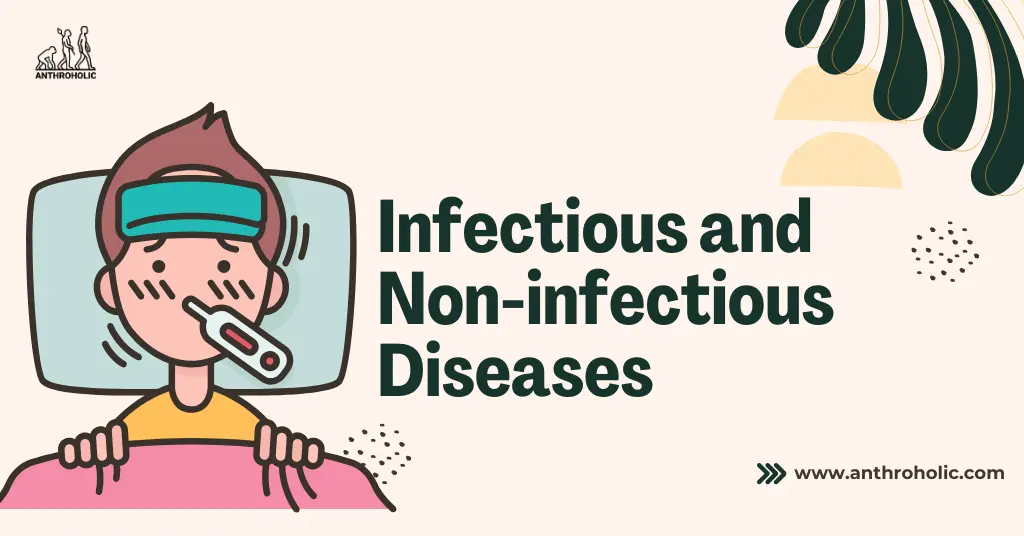AI Answer Evaluation Platform Live Now. Try Free Answer Evaluation Now
Infectious and Non-infectious diseases
Infectious and non-infectious diseases are two broad categories of diseases affecting millions worldwide. Understanding their differences, causes, and prevention methods is crucial for better healthcare outcomes.

Diseases, broadly classified into infectious and non-infectious, significantly impact global health. Infectious diseases are caused by pathogenic microorganisms, such as bacteria, viruses, parasites, or fungi; they can be spread, directly or indirectly, from one person to another. Non-infectious diseases, also known as non-communicable diseases (NCDs), are not caused by infectious agents and cannot be spread from person to person. They are often the result of genetic, physiological, environmental, and behavioral factors.
Infectious Diseases
Infectious diseases, also known as communicable diseases, are disorders caused by organisms such as bacteria, viruses, fungi, or parasites. Many of these organisms are generally harmless, and they can even be beneficial to the human body. However, under certain conditions, some organisms may cause disease.
Causes and Transmission
- Bacteria: These single-celled organisms are responsible for illnesses such as strep throat, urinary tract infections, and tuberculosis.
- Viruses: Smaller than bacteria, viruses cause a multitude of diseases ranging from the common cold to AIDS.
- Fungi: There are many varieties of fungi, and some can infect the human body, leading to diseases like athlete’s foot and ringworm.
- Parasites: Malaria is caused by a tiny parasite that is transmitted by a mosquito bite. Other parasites may be transmitted to humans from animal feces.
Infectious diseases can be spread through direct contact with an infected individual, indirect contact with contaminated objects, animal bites, or through contaminated food and water.
Symptoms and Diagnosis
Symptoms vary depending on the organism causing the infection but often include fever and fatigue. Mild infections may respond to rest and home remedies, while more severe infections might require hospitalization.
Many infectious diseases, such as measles and chickenpox, can be prevented by vaccines. Regular handwashing can also help prevent these diseases.
Treatment
Antibiotics are used to treat bacterial infections. It’s crucial not to use antibiotics for viral infections; they are ineffective against viruses and may lead to antibiotic resistance. Antiviral drugs can treat some viral infections, while antifungal medications are used for fungi and anti-parasitic drugs for parasites.
Non-infectious Diseases
Non-infectious diseases, also known as non-communicable diseases, are not caused by infectious agents and cannot be spread from person to person. These diseases are often chronic and tend to be long-lasting in their effects.
Types and Causes
- Cardiovascular Diseases: These include heart attacks and stroke, often caused by unhealthy diet, lack of exercise, smoking, and excessive alcohol consumption.
- Cancers: Caused by changes in the DNA within cells, leading them to grow uncontrollably. Environmental factors can trigger these changes.
- Chronic Respiratory Diseases: Such as asthma and chronic obstructive pulmonary disease (COPD), often exacerbated by smoking and environmental factors like air pollution.
- Diabetes: This results from the body’s inability to produce or properly use insulin.
Genetics, lifestyle choices, environmental factors, and aging are common causes of non-infectious diseases. Unlike infectious diseases, these are typically not preventable through vaccines or medicines.
Symptoms and Management
Symptoms vary widely depending on the disease. For instance, diabetes may present with increased thirst and urination, while heart disease may manifest as shortness of breath or chest pain.
Managing non-infectious diseases often involves lifestyle modifications, medication, and in some cases, surgery. For example, diabetes management includes blood sugar monitoring, diet, and possibly insulin therapy.
Prevention
Prevention strategies include maintaining a healthy lifestyle, regular exercise, avoiding tobacco and excessive alcohol, and regular medical check-ups.
Chronic vs. Acute Non-infectious Diseases
Non-infectious diseases are often chronic, meaning they last for a long time, often for a person’s entire life. Examples include diabetes and heart disease. However, some non-infectious diseases can be acute, such as certain types of injuries or nutritional deficiencies.
Risk Factors
- Genetic Factors: Some non-infectious diseases are hereditary, meaning they are passed down from parents to children through genes.
- Environmental Factors: Exposure to certain environmental factors, such as pollutants, chemicals, and radiation, can increase the risk of developing non-infectious diseases.
- Lifestyle Choices: Poor diet, lack of physical activity, and smoking are significant risk factors for many non-infectious diseases.
Global Impact and Challenges
Non-infectious diseases are the leading cause of death globally, particularly in middle- and high-income countries. They pose significant challenges to health systems due to their long-term nature and the need for continuous treatment and care. Additionally, they have a substantial economic impact due to lost productivity and the high costs of ongoing medical care.
Healthcare and Policy Implications
Effective management of non-infectious diseases often requires a combination of individual healthcare management and public health policies. This can include policies aimed at reducing risk factors, such as laws regulating tobacco and alcohol sales, urban planning that encourages physical activity, and public education campaigns about healthy lifestyles.
Research and Future Trends
Ongoing research into the causes and treatments of non-infectious diseases is crucial. This includes research into new medications, surgical techniques, and lifestyle modification programs, as well as public health strategies to reduce the burden of these diseases.
Conclusion
Non-infectious diseases, while not contagious, have a significant impact on health globally. The key to managing these diseases lies in understanding their multifactorial causes, which include genetics, environment, and lifestyle choices. With a combination of individual and collective efforts, including lifestyle changes, medical interventions, and public policies, it’s possible to reduce the impact of these diseases significantly.
Final Thoughts
Both infectious and non-infectious diseases represent significant health challenges worldwide. While they differ in causes and transmission methods, they both require comprehensive strategies for prevention, diagnosis, and management. Public health initiatives, education, and research play critical roles in combating these diseases and improving global health outcomes. Understanding these distinctions not only aids in medical treatment but also in the development of policies and practices that can mitigate their impact on societies worldwide.




